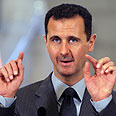
President Assad
צילום: EPA
7 million Syrians living in poverty
Years of neglect, corruption and lack of economic planning prompt popular protest, undeterred by regime's power. As President Assad tries to conceal depth of distress, residents overcome their fear after realizing they have nothing left to lose
The current anti-government riots in Syria stem from political, social, factional and economic motives. Years of international isolation, neglect, corruption and lack of economic planning have taken their toll.
The economic distress which only grew worse, especially in light of the global financial crisis and price hikes, broke loose after seeing the sparkle emerging from Tunisia and Egypt.
There is no doubt that the Syrian regime is relying on fear to silence the popular protest, as we have been witnessing since mid March. At the moment it seems that the protestors taking to the streets are mainly those who feel they have nothing left to lose.
Even before the current crisis, the Syrian authorities attempted to conceal the depth of the distress and poverty in the country. Last year, the government buried the findings of a report prepared together with the United Nations Development Program, titled "Indicators of poverty and division of income in Syria".
According to the study, the number of Syrians living under the poverty line reached 34% in 2004-2007 – i.e. one in every three Syrians lives in poverty. In absolute numbers we are talking about close to seven million people. More than 12% of the Syrian population – 2.5 million people – live in "shameful" poverty conditions.
Geographical poverty
The Syrian poverty has faces and names and a geographical division, and the periphery areas are the poorest in the country. Some 50% of Syria's poor are concentrated in these areas, and about 56% of them live in shameful poverty conditions. The Bashar Assad regime has banned the publication of these figures.
According to the findings, the northeastern part of the country is the poorest (the Kurdish areas of Hasaka and Kamishli). It is followed by the southern area, with Daraa at its center, which has become the focus of the current riots. In this area, researchers have found, the per capita spending was lower than the average spending of Syria's poor.
Several months ago, the newspaper of Rami Makhlouf, one of Syria's wealthiest people who is despised by the public, published data on the Syrian labor market. The figures published were biased, but those which were not presented can teach us about the situation.
According to the report, about 20% of the people employed in the country concentrated in the city of Aleppo. Daraa, the epicenter of the riots, is at the bottom of the list with about 4% of employed.
The article refrained from providing unemployment figures, but noted that it was high "among the young". Unofficial estimates put the unemployment rate among young Syrians at around 30%.
The Syrian leadership is familiar with all these data, but hoped that the massacre in the city of Hama about 30 years ago, in which the regime killed tens of thousands of residents, would help repress them. That didn't happen.
Doron Peskin is head of research at Info-Prod Research (Middle East) Ltd.
- Follow Ynetnews on Facebook










